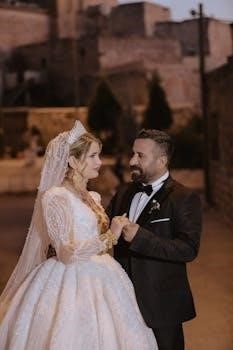The Meaning of Marriage⁚ A Comprehensive Overview

Marriage, often called matrimony or wedlock, is a culturally recognized union between individuals, establishing rights and obligations; It’s a legally sanctioned union, regulated by laws, customs, beliefs, and attitudes, encompassing a formal union and a social contract between two individuals.
In the 21st century, defining marriage requires navigating a complex landscape of evolving social norms, legal frameworks, and cultural values. Traditionally understood as a legally and socially sanctioned union, usually between a man and a woman, marriage is now increasingly recognized in diverse forms. This introduction seeks to explore the multifaceted meaning of marriage, considering its historical roots and contemporary transformations.
We will delve into how marriage functions as a fundamental building block of society, shaping family structures and interpersonal relationships. Examining various definitions, from legal contracts to religious sacraments, is crucial for a comprehensive understanding. The traditional definition of marriage as a union between one man and one woman is being challenged to modernize the definition of marriage.
This overview will address the shifting perceptions of marriage, including same-sex marriage, interracial marriage, and the growing acceptance of diverse family structures. Understanding these changes is essential for grasping the enduring importance of marriage in the modern world. This exploration will provide a framework for analyzing marriage as a social, legal, and personal institution.
Legal Definition of Marriage
The legal definition of marriage varies across jurisdictions but generally establishes it as a legally recognized union between two individuals, creating specific rights and obligations. It is recognized by law as a consensual and contractual relationship. This definition underscores marriage as a formal agreement, governed by state and federal laws, rather than solely a social or religious construct.
Legally, marriage involves a contract where partners agree to certain responsibilities, including financial support, property rights, and inheritance. Legal experts agree that the definition of cruelty in matrimonial matters will affect the legal definition of marriage. The state has the authority to regulate marriage, setting eligibility requirements such as age, consent, and prohibited relationships (e.g., incest).
Marriage is a legal partnership which creates economic bonds and is a formal union and a social and legal contract between two individuals.
The legal definition provides a framework for resolving disputes related to divorce, child custody, and spousal support. As societal norms evolve, the legal definition of marriage has also adapted, exemplified by the recognition of same-sex marriage in many countries. This evolution reflects a broader understanding of equality and individual rights within the institution of marriage.
Cultural Variations in Marriage
Marriage exhibits significant cultural variations worldwide, reflecting diverse social norms, traditions, and belief systems. These variations encompass aspects such as mate selection, wedding ceremonies, family structures, and the roles of spouses within the marriage.
In some cultures, marriages are arranged by families to strengthen social or economic ties, whereas, in others, individuals have the autonomy to choose their partners based on love and compatibility. Wedding ceremonies vary dramatically, ranging from elaborate multi-day celebrations to simple, intimate gatherings.
The structure of marriage also differs across cultures. While monogamy is the predominant form in many Western societies, polygamy (having multiple spouses) is practiced in certain regions and communities around the world. The roles and responsibilities of husbands and wives also vary, influenced by cultural expectations regarding gender, age, and social status.
Furthermore, cultural beliefs surrounding marriage can impact divorce rates, inheritance laws, and the social acceptance of different marital arrangements. Folkloristic anthropology studies the meaning and definitions of marriage. Understanding these cultural variations is crucial for appreciating the complexity and diversity of marriage as a social institution.

Marriage as a Social Contract
Marriage functions as a social contract, representing a formal agreement between two individuals that is recognized and sanctioned by society. This contract establishes mutual rights, obligations, and expectations within the marital relationship and towards the broader community. It signifies a public commitment to shared values, goals, and responsibilities.
As a social contract, marriage provides a framework for regulating interpersonal relationships, promoting stability, and ensuring the well-being of families and society as a whole. It often involves legal and economic considerations, such as property rights, inheritance, and spousal support. Furthermore, it establishes norms and expectations regarding fidelity, emotional support, and the upbringing of children.
The social contract of marriage varies across cultures and legal systems, reflecting different societal values and priorities. However, its fundamental purpose remains consistent⁚ to provide a structured framework for intimate relationships, promote social order, and ensure the continuity of society. The evolving definition of marriage reflects changing social attitudes and legal interpretations of this contract.
Religious Perspectives on Marriage
Religious perspectives on marriage vary significantly across different faiths and denominations, but often view marriage as a sacred union ordained by a higher power. Many religions consider marriage a fundamental institution, providing a framework for procreation, companionship, and spiritual growth. Religious ceremonies often mark the beginning of a marriage, symbolizing the couple’s commitment to each other and to their faith community.
In many religious traditions, marriage is seen as a covenant, a binding agreement between the couple and God. This covenant entails specific responsibilities and expectations, such as fidelity, mutual respect, and the upbringing of children in accordance with religious principles. Religious texts and teachings provide guidance on marital roles, responsibilities, and conflict resolution.
Different religions have varying views on the nature of marriage, including its purpose, duration, and permissible forms. Some religions emphasize the indissolubility of marriage, while others allow for divorce under certain circumstances. Religious perspectives on issues such as same-sex marriage and interfaith marriage also vary widely, reflecting diverse interpretations of religious texts and traditions.
Monogamy vs. Polygamy⁚ Types of Marriage
Marriage exists in various forms across cultures, with monogamy and polygamy representing two primary types. Monogamy, the most widely practiced form in modern societies, involves a union between two individuals. This can be either a man and a woman (heterosexual monogamy) or between two individuals of the same sex (homosexual monogamy), depending on legal and cultural contexts. Monogamy emphasizes exclusivity, emotional intimacy, and shared responsibilities between the spouses.
Polygamy, on the other hand, involves a marriage that includes more than two spouses. Polygamy can be further divided into polygyny, where one man is married to multiple women, and polyandry, where one woman is married to multiple men. Polygyny is more prevalent historically and geographically than polyandry. Polygamous marriages often arise from cultural, economic, or religious factors.
The legal status of polygamy varies significantly across countries. While monogamy is legally recognized in most nations, polygamy is either illegal or restricted in many jurisdictions. The debate surrounding the legality and social acceptance of polygamy often involves discussions about gender equality, individual rights, and religious freedom.
The Evolving Definition of Marriage

The definition of marriage has undergone significant evolution throughout history, reflecting societal shifts in values, norms, and legal frameworks. Traditionally, marriage was often viewed as a union primarily for procreation, economic stability, and social cohesion. However, contemporary understandings of marriage emphasize personal fulfillment, emotional connection, and individual autonomy.
One of the most notable changes in the definition of marriage is the increasing recognition of same-sex marriage. This has sparked debates about the fundamental nature of marriage and its inclusivity. The legalization of same-sex marriage in many countries signifies a move towards a more egalitarian and diverse understanding of marital relationships.
Furthermore, the concept of marriage has been influenced by changing gender roles, increased emphasis on individual rights, and evolving attitudes towards family structures. Today, marriage is increasingly seen as a partnership based on mutual respect, shared goals, and emotional intimacy, rather than solely a legal or social obligation. The evolving definition of marriage reflects the ongoing negotiation between tradition and modernity, personal choice and societal expectations.
Marriage and Family Formation

Marriage plays a central role in the formation of families, serving as a foundational institution for raising children and transmitting cultural values across generations. Historically, marriage has been closely linked to procreation and the creation of stable family units. However, the relationship between marriage and family formation has become more complex in recent years.
With the rise of diverse family structures, including single-parent families, blended families, and same-sex parented families, the traditional notion of marriage as the sole basis for family formation has been challenged. While marriage remains a significant pathway to parenthood for many, it is no longer the only option.
Moreover, advancements in reproductive technologies have enabled individuals and couples to have children outside of traditional marriage. This has led to a broader understanding of family that encompasses various forms of kinship and caregiving. Marriage continues to provide a legal and social framework for raising children, but its role in family formation is increasingly intertwined with individual choices, evolving social norms, and diverse family arrangements.
Consummation of Marriage⁚ Meaning and Significance
Consummation of marriage refers to the first act of sexual intercourse between a married couple following the wedding ceremony. Traditionally, consummation has been viewed as an essential component of a valid marriage, symbolizing the physical union and completion of the marital bond. In many legal and religious contexts, consummation serves as proof that the marriage is not merely a formal agreement but a genuine union of two individuals.
The significance of consummation extends beyond its legal and religious implications. It represents the couple’s mutual commitment, intimacy, and desire to build a life together. Consummation marks the beginning of their shared physical and emotional journey as husband and wife.
However, the role of consummation in modern marriage has evolved. While it remains a meaningful experience for many couples, it is no longer universally considered a mandatory requirement for a valid marriage. Some legal systems have abolished the requirement of consummation, recognizing that a marriage can be valid even if the couple chooses not to engage in sexual relations.
Cruelty as a Ground for Divorce
Cruelty, as a ground for divorce, refers to behavior by one spouse that causes physical, emotional, or mental harm to the other spouse, making it unsafe or unreasonable for them to continue living together. The definition of cruelty varies across jurisdictions, but it generally involves acts that demonstrate a lack of care and consideration for the well-being of the other spouse.
Physical cruelty includes acts of violence, such as hitting, pushing, or other forms of physical abuse. Emotional cruelty, on the other hand, involves behaviors that cause significant emotional distress, such as verbal abuse, insults, threats, or intimidation. Mental cruelty encompasses actions that undermine the spouse’s mental health, such as constant criticism, humiliation, or isolation.
To establish cruelty as a ground for divorce, the spouse must demonstrate that the other spouse’s behavior was intentional, severe, and had a significant impact on their well-being. The court will consider the nature and frequency of the acts, as well as the overall context of the marriage, to determine whether the behavior constitutes cruelty.
In conclusion, marriage, despite its evolving definition and societal shifts, retains enduring importance in many societies. It provides a framework for building families, fostering emotional intimacy, and establishing legal rights and responsibilities between partners. Marriage can offer stability, security, and a sense of belonging, contributing to the well-being of individuals and communities.
The legal recognition of marriage provides certain rights and protections to spouses, such as inheritance rights, healthcare benefits, and the ability to make decisions on behalf of each other. Marriage also serves as a social contract, establishing expectations and norms for behavior within the relationship and towards society.
While the traditional definition of marriage may have been challenged, its core values of commitment, love, and mutual support remain relevant. The evolving definition of marriage reflects changing social attitudes and values, but its fundamental purpose of creating a lasting bond between individuals remains constant.
